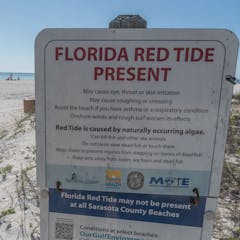
Articles on Nutrient pollution
Displaying 1 - 20 of 26 articles

Did the Green Revolution, which brought high-tech agriculture to developing nations in the 1960s, prevent famine? Recent research takes a much more skeptical view.

Developers will no longer have to offset nutrient pollution from new housing projects – the UK government say this won’t degrade water quality.

Conventional agriculture offers farmers few choices about which crops to grow or how to raise them. A new approach uses computing to construct better strategies with lower environmental impacts.

Seagrasses need light to remain resilient to marine heatwaves – water pollution disrupts that balance.

The tiny organisms that cause harmful blooms of algae can have a big impact on your trip to the shore. A toxicologist explains what causes these events and how to keep people and pets safe.

Scientists are predicting a record sargassum bloom in 2023. It’s already starting to wash up on beaches in Florida and the Caribbean and cause a stink.

Shall I order the chicken, or the salmon? What does the science say about reducing pressure on the environment? When you take a big-picture view, the results can be surprising.

The US Supreme Court opens its 2022-2023 term with a case that could greatly reduce federal protection for wetlands. Here is what makes these ecosystems valuable.

Nutrient pollution fouls lakes and bays with algae, killing fish and threatening public health. Progress curbing it has been slow, mainly because of farm pollution.

It’s possible to feed the world’s 7.8 billion people with more environmentally friendly farming practices. Here’s how.

New research shows that one-third of yearly nitrogen runoff from Midwest farms to the Gulf of Mexico occurs during a few heavy rainstorms. New fertilizing schedules could reduce nitrogen pollution.

Cuba’s sustainable approach to farming has protected its rivers from the kind of nutrient pollution that impairs many US waterways.

Warmer waters, heavier storms and nutrient pollution are a triple threat to Great Lakes cities’ drinking water. The solution: Cutting nutrient releases and installing systems to filter runoff.

Should lakes, rivers and other resources have legal rights? New Zealand, Ecuador and other countries have taken this step. Now Toledo, Ohio is a US test case.

Scientists are predicting major algae blooms in Lake Erie and large dead zones in the Chesapeake Bay and Gulf of Mexico this summer. Nutrient pollution from industrial corn farming is a major driver.

The Trump administration wants to end federal protection under the Clean Water Act for many small streams and wetlands. But as a geoscientist explains, these are critical parts of large river systems.

Fertilizer is a key source of nitrogen pollution which fouls air and water worldwide. Current regulations target farmers, but focusing on producers could spur them to develop greener products.

Drastic oxygen losses in the world’s oceans millions of years ago coincided with mass extinctions. Scientists see this as a warning about how climate change could affect oceans today.

Red tide and a blue-green algae outbreak are fouling hundreds of miles of coast, killing fish and driving tourists away from beaches. Some of the causes are natural, but human actions play a big role.

Scientists have mapped a huge dead zone in the Gulf of Oman, without enough oxygen in the water to support life. This Speed Read explains why dead zones form in waters around the world.
